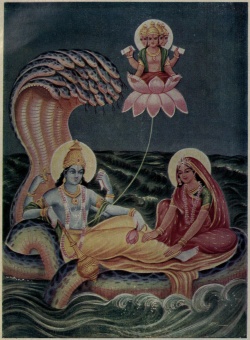Nārāyaṇa: Difference between revisions
Jump to navigation
Jump to search
Pablo Sender (talk | contribs) (Created page with "right|150px '''Nārāyaṇa''' is the Supreme Being (Purushottama or Supreme Purusha) in Hindu sacred texts such as the Bhagavad Gita, the Vedas an...") |
Pablo Sender (talk | contribs) No edit summary |
||
| Line 1: | Line 1: | ||
[[File:Vishnu-Narayan.jpg|right| | [[File:Vishnu-Narayan.jpg|right|250px]] | ||
'''Nārāyaṇa''' is the Supreme Being (Purushottama or Supreme Purusha) in Hindu sacred texts such as the Bhagavad Gita, the Vedas and the Puranas. In Vaishnavism, also known as [[Viṣṇu|Vishnu]] and Hari. An important translation of Narayana is "the One who rests on Water," and he is frequently depicted in Hindu art as standing or sitting on an ocean. | '''Nārāyaṇa''' is the Supreme Being (Purushottama or Supreme Purusha) in Hindu sacred texts such as the Bhagavad Gita, the Vedas and the Puranas. In Vaishnavism, also known as [[Viṣṇu|Vishnu]] and Hari. An important translation of Narayana is "the One who rests on Water," and he is frequently depicted in Hindu art as standing or sitting on an ocean. | ||
[[Category:Sanskrit terms|Narayana]] | [[Category:Sanskrit terms|Narayana]] | ||
Revision as of 22:51, 10 August 2016
Nārāyaṇa is the Supreme Being (Purushottama or Supreme Purusha) in Hindu sacred texts such as the Bhagavad Gita, the Vedas and the Puranas. In Vaishnavism, also known as Vishnu and Hari. An important translation of Narayana is "the One who rests on Water," and he is frequently depicted in Hindu art as standing or sitting on an ocean.
